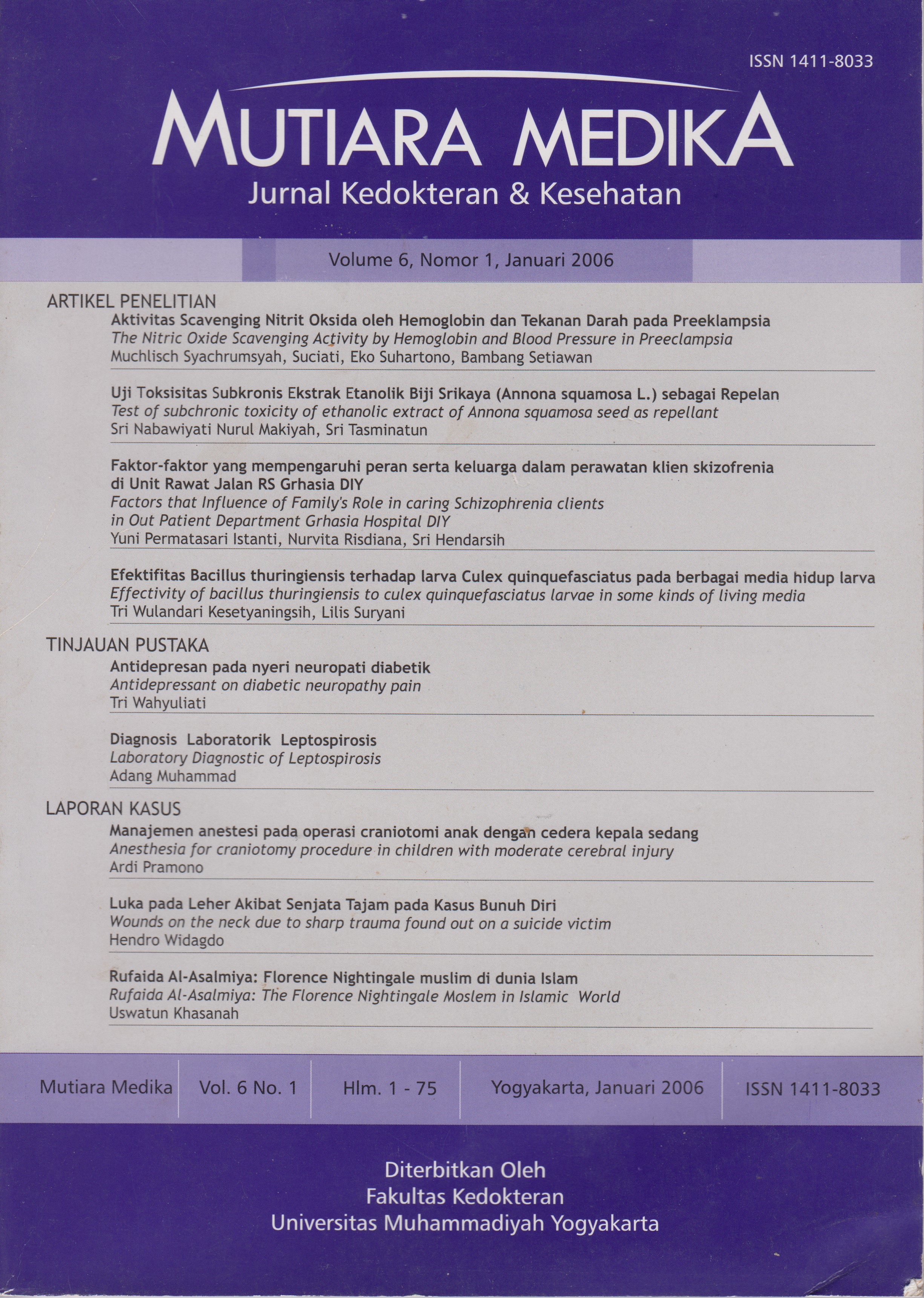Efektifitas Bacillus Thuringiensis Terhadap Larva Culex Quinquefasciatus Pada Berbagai Media Hidup Larva
DOI:
https://doi.org/10.18196/mmjkk.v6i1.1882Keywords:
Bacillus thuringiensis, Culex quinquefasciatus, bioinsektisida, bioinsecticideAbstract
One of mosquito that transmitted this disease is Culex quinquefasciatus. Insecticide commonly use for vector control because it can reduce mosquito population easily and rapidly, but have a high risk to pollution and resistancy. Bacillus thuringiensis (Bti) is bacteria that produce toxic crystal to larvae of Coleoptera, Diptera and Lepidoptera. The purpose of this study is to know the efficacy of Bti as larvicide to Cx. quinquefasciatus (L3) that live in media biologic water, rice field water and cesspool water and compare the larvae ’s death among those groups.Subject of this study is Bti (strain H-14) Vectobac 12 US in liquidformula from Abott, USA, then examined its effectivity as larvicide to Cx quinquefasciatus. Twenty larvaes (L3) entered into every group that filled 100 ml of 1,2,3,4,5, and 6 ppm Bti solution and negative group. Observation was carried out after 24 hours exposure to get % of larvae s death. Larvae s death was decided if there is no movement by stick touched. Probit analysis used to decide LD50 and LD 95 and One way anova used to know the significancy difference of% larvae s death among research groups.
The result shows that Bti is effective to Cx. quinquefasciatus larvae with LD50 1,43 ppm in aquades group, 2,28 ppm in field water group and 4,56 ppm in cesspool water group. There is no significant difference of% larvae ’s death among research groups.
Salah satu nyamuk vektor filariasis adalah Culex quinquefasciatus. Pengendalian vektor dengan insektisida digunakan karena dapat menurunkan populasi nyamuk secara cepat, mudah dan dalam jumlah banyak, namun dapat menyebabkan pencemaran lingkungan dan beresiko terjadi resistensi. Bacillus thuringiensis (Bti) adalah bakteri pembentuk spora menghasilkan kristal toksik terhadap larva Coleoptera, Diptera dan Lepidoptera. Penelitian ini bertujuan mengetahui efektifitas Bti terhadap larva Cx quinquefasciatus (L3) pada tiga macam media hidup larva yaitu comberan, air sawah dan akuades serta membandingkan diantara ketiganya.
Subyek penelitian adalah Bti (strain H-14) Vectobac 12 AS formula cair dari Abott, diuj i efektifitasnya sebagai larvisida Cx quinquefasciatus yang hidup pada media air biologis comberan, air sawah dan akuades. Tiap kelompok terdiri atas enam konsentrasi Bti (1,2,3,4,5 dan 6 ppm) dan kontrol negatif (tanpa Bti) yang dilarutkan dalam 100 ml air media hidup larva dan diisi 200
Korespondensi: Tri Wulandari K, Fakultas Kedokteran Universitas Muhammadiyah Yogyakarta, Jin. Lingkar Barat Tamantirto Kasihan Bantul Yogyakarta
ekor L3 Cx. quinquefasciatus. Pengamatan dilakukan 24 setelah pemaparan dengan menghitung prosentase kematian larva. Larva dinyatakan mati bila sama sekali tidak bergerak setelah diusik dengan ujung pipet larva. Analisis Probit digunakan untuk menentukan LD50 dan LD95 dan analisa varians digunakan untuk menentukan signifikansi perbedaan prosen kematian diantara ketiga kelompok perlakuan.
Hasil penelitian menunjukkan Bti efektif sebagai larvisida Cx. quinquefasciatus dengan LD50 1,43 ppm pada akuades, 2,28 ppm .pada air sawah dan 4,56 ppm pada comberan sebagai media hidup larva. Tidak ada perbedaan bermakna diantara ketiga media hidup larva yang diujikan.
References
Markeli, EK, M.Voge, and John, D.T., 1986. Medical Parasitology. W.B. Saunders Company, Philadelphia, London, Toronto, Mexico city, Rio de janeiro, Sydney, Tokyo, Hongkong. P. 243.
Kesetyaningsih.T.W., 2004. Efek antimikrofilaria Albendazole terhadap Brugia malayi pada Meriones unguiculatus secara invivo. MKI. Vol. 54. No.2. hal 43-47.
WHO, 1992. Informal Consultation on the Development of Bacillus sphaericus as a microbial larvicide. TDR/BC/sphaericus/85.pp 11-17.
Depkes, 1987. Pemberantasan vector dan cara-cara evaluasinya. Ditjen PPM dan PLP, Depkes. Rl., Jakarta. Hal. 13- 34
Suharyono, 1987. Penaggulangan DBD dengan fogging malathion pada tempat penularan potensial di Jakarta. Majalah kesehatan. DerKes., Jakarta.
WHO, 1999. Environmental health criteria : Bacillus thuringiensis, EHC217,.
Jenssen,G.B, Larsen,R,Jacobsen,B., et al. 2002. Bacillus thuringiensis in fecal samples fromm green house workers after exposure to B. thuringiensisbased pesticides. Journal Virology Applied and Environmental Microbiology. Vol 68. No. 10. pp 490-495
Service, M.W., 1996. Medical Entomology. Chapman and Hall, London, pp 75-130
Blondine, ChD. dan Yuniarti, 2004. Lama penyimpanan galur local Bacillus thuringiensis H-14 dalam buah kelapa dan uji efikasinya terhadap berbagai jentik nyamuk vector di laboratorium. Proceeding SeminarTrocical medicine, Universitas Airlangga, Surabaya.
Downloads
Issue
Section
License
Copyright
Authors retain copyright and grant Mutiara Medika: Jurnal Kedokteran dan Kesehatan (MMJKK) the right of first publication with the work simultaneously licensed under an Attribution 4.0 International (CC BY 4.0) that allows others to remix, adapt and build upon the work with an acknowledgment of the work's authorship and of the initial publication in Mutiara Medika: Jurnal Kedokteran dan Kesehatan (MMJKK).
Authors are permitted to copy and redistribute the journal's published version of the work (e.g., post it to an institutional repository or publish it in a book), with an acknowledgment of its initial publication in Mutiara Medika: Jurnal Kedokteran dan Kesehatan (MMJKK).
License
Articles published in the Mutiara Medika: Jurnal Kedokteran dan Kesehatan (MMJKK) are licensed under an Attribution 4.0 International (CC BY 4.0) license. You are free to:
- Share — copy and redistribute the material in any medium or format.
- Adapt — remix, transform, and build upon the material for any purpose, even commercially.
This license is acceptable for Free Cultural Works. The licensor cannot revoke these freedoms as long as you follow the license terms. Under the following terms:
Attribution — You must give appropriate credit, provide a link to the license, and indicate if changes were made. You may do so in any reasonable manner, but not in any way that suggests the licensor endorses you or your use.
- No additional restrictions — You may not apply legal terms or technological measures that legally restrict others from doing anything the license permits.






